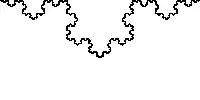Many country borders are determined by rivers, which are fractal in nature. Other country borders are determined by other natural phenomena such as mountain ranges and coastlines.
(edited) Main question
Because they are often defined by natural phenomena, Can we learn anything about international boundaries if we model them as fractals? (Thank you to @XanderHenderson for both this re-framing of the question and his thorough answer.)
Rivers
For country borders determined by rivers, See this list of international Border Rivers. The start of the European list:
- Ardila River: Spain and Portugal
- Bug River: Belarus and Poland
- Bug River: Ukraine and Poland
- Danube: Austria and Slovakia
- Danube: Croatia and Serbia
See also The fractal nature of river networks.
(edit) In Calculation on fractal dimension of river morphology, the authors have calculated the fractal dimensions of various rivers:
The fractal dimensions of stream length in Haihe River baisn vary from 1.01 to 1.14, and its mean value is 1.10. The fractal dimensions of Lanhe River and Daqing River are larger because their stream channels are zigzag.
Coastlines
The coastline paradox is the counterintuitive observation that the coastline of a landmass does not have a well-defined length. This results from the fractal-like properties of coastlines, i.e., the fact that a coastline typically has a fractal dimension (which in fact makes the notion of length inapplicable). The first recorded observation of this phenomenon was by Lewis Fry Richardson and it was expanded upon by Benoit Mandelbrot. Coastline Paradox
Exceptions
Some country borders were drawn through treaty, such as the 38th parallel in Korea and the 49th parallel between the US and Canada.
Related questions
What sorts of problems can fractals solve? OP states "I already know people use fractals to map coastlines and borders"
What exactly are fractals Accepted answer says, "[A] fractal is one thing, and certain methods for constructing particular fractals are another."
From English Language and Usage / Irregular shape with projections and recesses that interlock with other shapes This OP's answer was "The borders between countries may be fractal in nature."
Motivation
This question is intended for the mathematics community, which has an understanding of fractal that is distinct from the English community.
Presuming that the answer to this question will be a "yes" or a "yes with caveats," I'd also like to solicit a researched, cogent "no" response.
(edit) This OP was surprised that the answers were populated with cogent "no" responses to the original question: "Are country borders fractal?" The main objections are that fractal is not well defined XanderHenderson and that the fractal is mathematical concept and "There are no instances of fractals in the physical world." YvesDaoust
